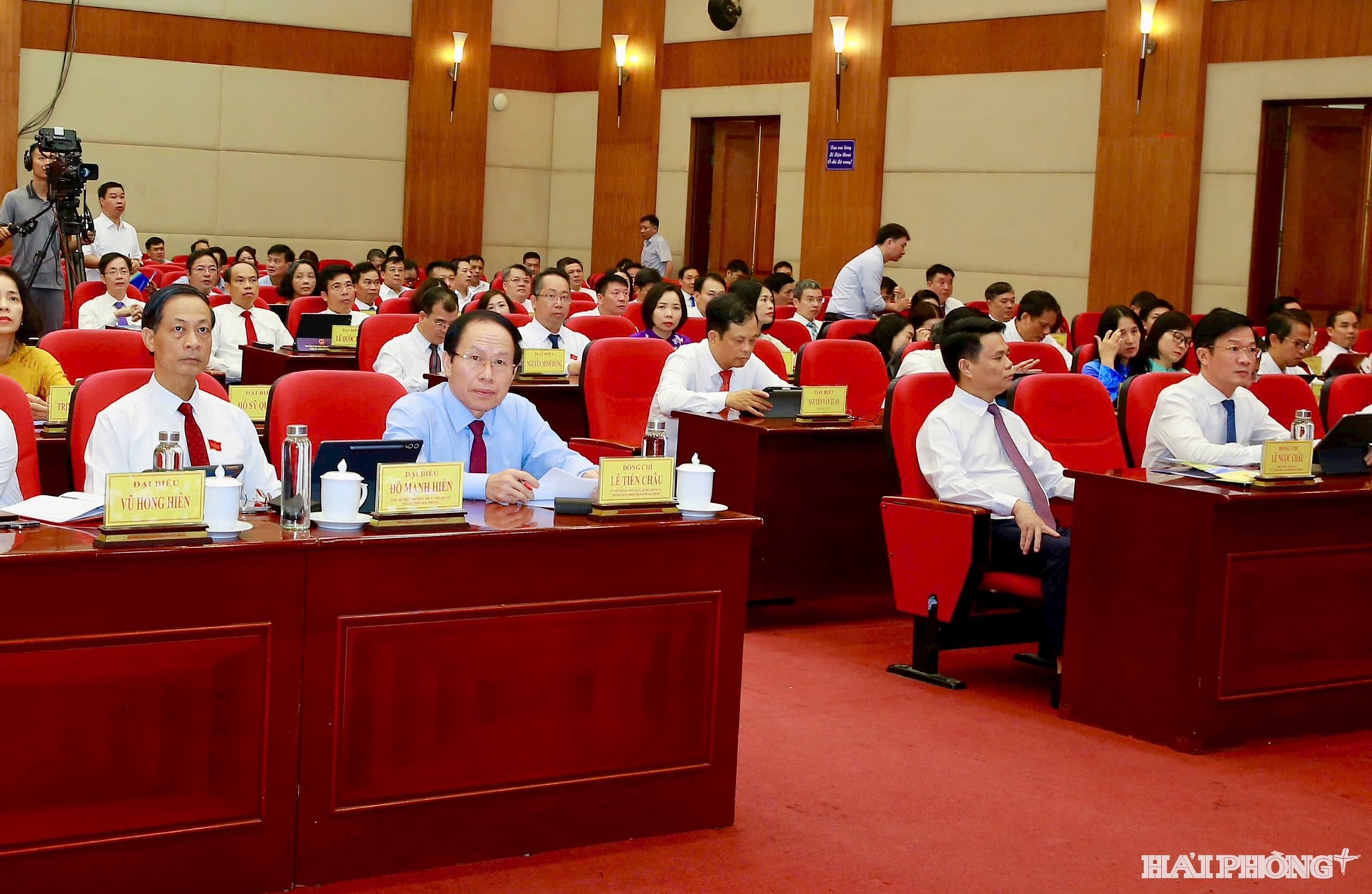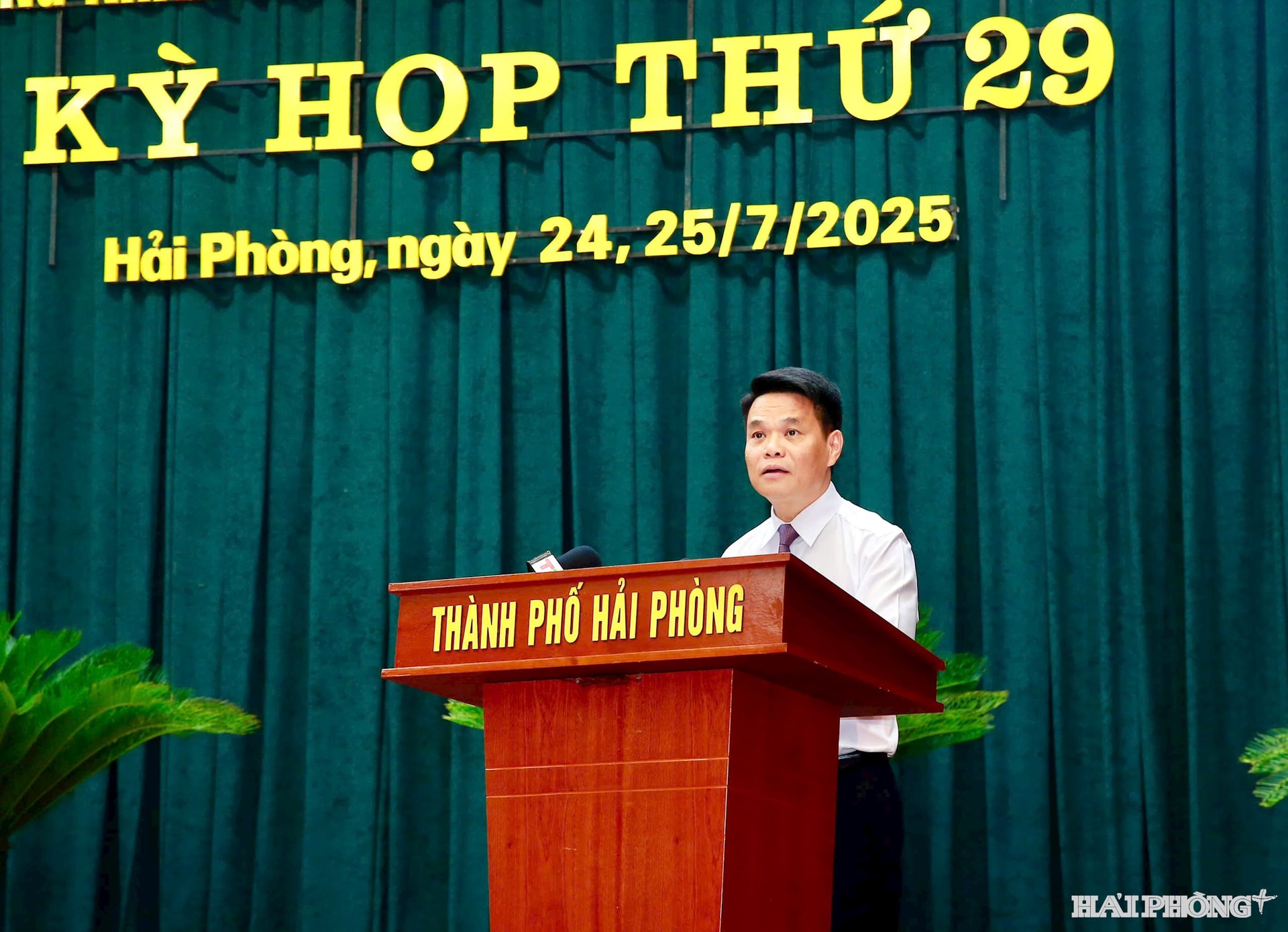Hai Phong's GRDP was estimated at over 209.6 trillion VND in the first half of 2025, ranking second out of 34 provinces and cities in the country and first among the six Centrally-run cities.

Chairman of the Hai Phong City People’s Committee Le Ngoc Chau delivered a report on the city’s socio-economic development plan for 2025 and key tasks and solutions for the second half of the year following the recent merger of the city and Hai Duong province at the 29th session of the 16th city People's Council on July 24 morning.
Hai Phong maintains double-digit growth momentum
Chairman of the city People’s Committee Le Ngoc Chau emphasized that 2025 is a particularly important year, the final year of the 2020–2025 term.
Hai Phong, together with the rest of the country, is making its utmost efforts to achieve multiple key objectives simultaneously: boosting economic growth, thoroughly preparing for the successful organization of Party congresses at all levels, and operating the new two-tier local government model in a streamlined, efficient, and effective manner.

Despite complex developments in global and regional situations and intertwined challenges and opportunities in the first six months of the year, Hai Phong still fundamentally achieved its socio-economic goals thanks to the determination and efforts of the entire political system.
The city's gross regional domestic product (GRDP), at constant 2010 prices, was estimated at over 209.6 trillion VND in the first half of 2025, up 11.2% year-on-year and 1.5 times higher than the national average, ranking second out of 34 provinces and cities in the country and first among the six Centrally-run cities as well as those in the Red River Delta region.
The industrial production index rose by 14.6% compared to the same period in 2024, 1.6 times higher than the national average (9.2%).

Total state budget revenue exceeded 100 trillion VND, with over 58.4 trillion VND from domestic sources and more than 41.3 trillion VND from import-export activities.
Total investment disbursed in the locality exceeded 139.8 trillion VND, up nearly 19% over the same period last year.
The city welcomed more than 7.5 million tourists, achieving 52% of the year’s plan, up over 28% year-on-year. Foreign direct investment reached approximately 1.3 billion USD. More than 3,300 new businesses were established, meeting 56% of the 2025 target.
Remarkable socio-economic highlights
.jpeg)
Chairman Le Ngoc Chau outlined the key achievements in socio-economic development during the first half of the year.
One standout was the decisive and synchronized implementation of the new two-tier local government model, which has been operating smoothly from the outset.
Hai Phong successfully completed its project and closely coordinated with Central agencies to request the National Assembly to issue a resolution on piloting special mechanisms and policies for the city’s development.
The city continued to implement major works and projects across various sectors such as transportation and urban areas, helping to elevate the city's strategic position and pave the way for growth in various socio-economic areas.
Notably, the Prime Minister approved investment in terminals No. 9 - 12 in Lach Huyen port. The city also submitted proposals for the appraisal and approval of a specialized economic zone…
Before the merger, Hai Phong was officially recognized by the Prime Minister as having fulfilled the national target of building new-style rural areas in 2024. The city also hosted numerous significant political, economic, and cultural events, leaving a strong impression on both domestic and international audiences.
.jpg)
Most recently, Hai Phong successfully organized its 2025 Investment Promotion Conference on the sidelines of the third ABAC meeting, themed “Hai Phong – A strategic gateway to the new era.”
Cultural, social, sports, healthcare, education, science and technology, and digital transformation fields all achieved positive outcomes. Social security was implemented in a timely and targeted manner, while public security and order remained stable. The living standards of residents continued to improve both materially and spiritually.
Key post-merger tasks
To accomplish the socio-economic targets for 2025 and the second half of the year, the city People’s Committee identified major goals and key tasks.
These include ensuring the effective operation of the two-tier local government model in tandem with successfully organizing Party congresses at all levels leading up to the 14th National Party Congress. The city will also regularly review and update its economic growth scenarios to support the city authorities’ direction and administration.
Resources will be prioritized to promote growth, aiming for an annual growth rate of over 12.35% to lay a solid foundation for the next development phase.
The city will accelerate the implementation of the National Assembly’s Resolution No. 226, dated June 27, 2025 on piloting special mechanisms for Hai Phong's development. Focus will also be placed on promptly and effectively deploying the city’s southern and western economic zones, particularly its free trade zone.
Decisive and synchronous measures will be taken to maintain and significantly improve the city’s rankings in administrative reform, provincial competitiveness, public governance, and citizen satisfaction to create a transparent and favorable investment and business environment to attract off-budget resources.
The city will also pay attention to the development of cultural and social sectors, ensure national defense and security, especially social welfare, by reviewing mechanisms and policies to ensure uniform implementation after merger.
Hai Phong News